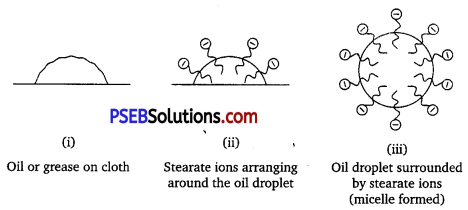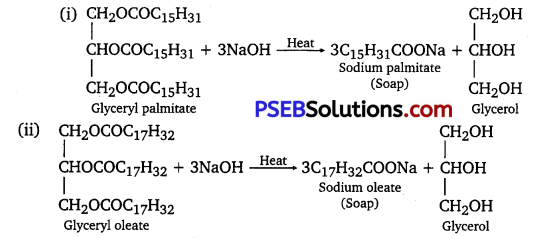Punjab State Board PSEB 12th Class Chemistry Book Solutions Chapter 16 Chemistry in Everyday Life Textbook Exercise Questions and Answers.
PSEB Solutions for Class 12 Chemistry Chapter 16 Chemistry in Everyday Life
PSEB 12th Class Chemistry Guide Chemistry in Everyday Life InText Questions and Answers
Question 1.
Why do we need to classify drugs in different ways?
Answer:
Different ways of classification of drugs and the usefulness of such classification are as follows :
- Classification on the basis of pharmacological effect is useful for doctors because it provides them the whole range of drugs available for the treatment of a particular type of problem.
- Classification on the basis of drug action on a particular biochemical process is useful for choosing the correct lead compound for designing the synthesis of a desired drug.
- Classification on the basis of molecular targets is useful for medicinal chemists so that they can design a drug which is most effective for a particular receptor site.
- Classification on the basis of chemical structure is useful for doctors to design the synthesis of a number of structurally similar compounds having different substituents and then choosing the drug having the least toxicity.
Question 2.
Explain the term target molecules or drug targets as used in medicinal chemistry.
Answer:
Drugs interact with macromolecules such as proteins, carbohydrates, lipids, enzymes and nucleic acids. Hence, these are called drug targets. Drugs possessing some common structural features may have the same mechanism of action on targets.
Question 3.
Name the macro-molecules that are chosen as drug targets.
Answer:
Nucleic acids, proteins, carbohydrates, lipids, enzymes are chosen as drug targets.
Question 4.
Why should not medicines be taken without consulting doctors?
Answer:
Side effects are caused when a drug binds to more than one receptor site. So, a doctor must be consulted to choose the right drug which has the maximum affinity for a particular receptor site to have the desired effect. The dose of the drug is also crucial because some drugs like opiates in higher doses act as poisons and may cause death.
![]()
Question 5.
Define the term chemotherapy.
Answer:
The branch of chemistry which deals with the treatment of diseases using chemicals is called chemotherapy.
Question 6.
Which forces are involved in holding the drugs to the active site of enzymes?
Answer:
Ionic bonding, hydrogen bonding, van der Waals’ interaction, dipole-dipole interaction etc., are involved in holding the drugs to the active site of enzymes.
Question 7.
While antacids and antiallergic drugs interfere with the function of histamines, why do these not interfere with the function of each other?
Answer:
These (antacids and antiallergic drugs) do not interfere with the function of each other because they work on different receptors in the body.
Question 8.
Low level of noradrenaline is the cause of depression. What type of drugs are needed to cure this problem? Name two drugs.
Answer:
In event of low level of neurotransmitters, noradrenaline, antidepressant drugs are required. These drugs inhibit the enzymes which catalyse the degradation of noradrenaline. If the enzyme is inhibited, noradrenaline is slowly metabolised and thus activates its receptor for longer periods of time thereby reducing depression. Two important drugs are iproniazid and phenelzine.
Question 9.
What is meant by the term ‘broad-spectrum antibiotics? Explain.
Answer:
Broad-spectrum antibiotics are effective against several different types of harmful bacteria. Examples are tetracycline, ofloxacin, chloramphenicol, etc. Chloramphenicol can be used in case of typhoid, acute fever, dysentery, urinary infections, meningitis and pneumonia.
Question 10.
How do antiseptics differ from disinfectants? Give one example of each.
Answer:
Differences between antiseptics and disinfectants are as follows :
Antiseptics
- Antiseptics are chemical substances which prevent the growth of microorganisms and may even kill them but are not harmful to living tissues.
- Antiseptics are generally applied to living tissues such as wounds, cuts, ulcers and diseased skin surfaces.
- Dettol, furnace, soframicine are antiseptics.
Disinfectants
- Disinfectants are chemical substances which kill microorganisms or stop their growth but are harmful to human tissues.
- Disinfectants are applied to inanimate objects such as floor, drainage system, instruments, etc.
- Chlorine in the concentration of 0.2 to 0.4 ppm in aqueous solution and SO 2 in very low concentration are disinfectants.
Question 11.
Why are cimetidine and ranitidine better antacids than sodium hydrogen carbonate or magnesium or aluminium hydroxide?
Answer:
Excessive use of sodium hydrogen carbonate or a mixture of aluminium and magnesium hydroxide can make the stomach alkaline and trigger the production of even more acid. On the other hand, ranitidine and cimetidine prevent the interaction of histamine with the receptors present in the stomach wall. This results in release of lesser amount of acid. Thus, these are better antacids.
![]()
Question 12.
Name a substance which can be used as an antiseptic as well as disinfectant.
Answer:
0.2% solution of phenol acts as an antiseptic while 1% of the solution acts as a disinfectant.
Question 13.
What are the main constituents of Dettol?
Answer:
Chloroxylenol and a-terpineol in a suitable solvent.
Question 14.
What is tincture of iodine? What is its use?
Answer:
A 2-3 per cent solution of iodine in alcohol-water mixture is known as tincture of iodine. It is used as an antiseptic.
Question 15.
What are food preservatives?
Answer:
Chemical substances which are used to protect food against bacteria, yeasts and moulds are called food preservatives. For example, sodium metabisulphite, sodium benzoate, etc.
Question 16.
Why is the use of aspartame limited to cold foods and drinks?
Answer:
Aspartame decomposes on heating and may not work well. So, its use as an artificial sweetener is limited to foods and drinks at low temperatures.
Question 17.
What are artificial sweetening agents? Give two examples.
Answer:
Artificial sweetening agents are the chemical substances which provide sweetness to the food without increasing the calories to the body. For example, saccharin, aspartame, sucralose etc.
Question 18.
Name the sweetening agent used in the preparation of sweets for a diabetic patient.
Answer:
Saccharin.
Question 19.
What problem arises in using alitame as artificial sweetener?
Answer:
Alitame is a high potency artificial sweetener. Therefore, it becomes difficult to control die level of sweetness while using it.
Question 20.
How are synthetic detergents better than soaps?
Answer:
Advantages of synthetic detergents over soaps :
- Detergents can work with hard water too while soaps cannot.
- They can work even in an acidic medium while soaps cannot.
- Synthetic detergents are stronger cleansing agents than soaps.
- Their solubility is higher than that of soaps.
- They are prepared from hydrocarbons (petroleum) so their use is to save vegetable oils which are used during the preparation of soaps.
Question 21.
Explain the following terms with suitable examples :
(i) Cationic detergents
(ii) Anionic detergents and
(iii) Non-ionic detergents
Answer:
(i) Cationic detergents: These are quaternary ammonium salts of amines with acetates, chlorides or bromides.
Example: Cetyl trimethyl ammonium bromide
(ii) Anionic detergents: These detergents have large anionic part in their molecules. These are of two types :
(a) Sodium alkyl sulphates: For example, Sodium lauryl sulphate CH3 (CH2)10 CH2OSO3–Na+.
(b) Sodium alkyl benzene sulphonates: For example, sodium dodecylbenzene sulphonate
![]()
(iii) Non-ionic detergents: These are esters of high molecular mass alcohols with fatty acids. For example, Polyethylene glycol stearate.
CH3 (CH2)16 COO(CH2CH2O)nCH2CH2OH.
![]()
Question 22.
What are biodegradable and non-biodegradable detergents? Give one example of each.
Answer:
Detergents having straight hydrocarbon chains are easily degraded by microorganisms and hence are called biodegradable detergents, whereas detergents containing branched hydrocarbon chains are not easily degraded by the microorganisms and hence are called non-biodegradable detergents. As a result, non-biodegradable detergents accumulate in rivers and waterways thereby causing severe water pollution.
Examples of biodegradable detergents are : sodium lauryl sulphate, sodium 4-(l-dodecyl) benzene-sulphonate and sodium 4-(2-dodecyl) benzenesulphonate. An example of non-biodegradable detergent is sodium 4-(l, 3, 5, 7-tetramethyloctyl) benzenesulphonate.
Question 23.
Why do soaps not work with hard water?
Answer:
Calcium and magnesium salts present in hard water react with soaps to form insoluble compounds, which form curdy white precipitates and are difficult to remove from the clothes.

Question 24.
Can you use soaps and synthetic detergents to check the hardness of water?
Answer:
We can use soaps to check the hardness of water because with hard water, soaps give a gummy mass (sticky precipitate) but we cannot use detergents for this purpose because they give foam with both hard and soft water.
Question 25.
Explain the cleansing action of soaps.
Answer:
The cleansing action of soap is due to the fact that soap molecules, such as sodium stearate form micelle around the oil droplet in such a way that hydrophobic part of the stearate ions is in the oil droplet and hydrophilic part projects out of the oil droplet like the bristles.
Since the polar groups can interact with water, the oil droplet surrounded by stearate ions is now pulled in water and removed from the dirty surface. Thus, soap helps in emulsification and washing away of oils and fats. The negatively charged sheath around the globules prevents them from coming together and forming aggregates.

Question 26.
If the water contains dissolved calcium hydrogen carbonate, out of soaps and synthetic detergents which one will you use for cleaning clothes?
Answer:
Synthetic detergents.
![]()
Question 27.
Label the hydrophilic and hydrophobic parts in the following compounds.
(i) CH3(CH2)10CH2OSO3–Na+
(ii) CH3(CH2)15N+(CH3)3 Br–
(iii) CH3(CH2)16COO(CH2CH2O)n CH2CH2OH
Answer:

Chemistry Guide for Class 12 PSEB Chemistry in Everyday Life Textbook Questions and Answers
Question 1.
Sleeping pills are recommended by doctors to the patients suffering from sleeplessness but It is not advisable to take Its doses without consultation with the doctor. Why?
Answer:
Sleeping pills contain drugs that may be tranquillizers or antidepressants. They affect the nervous system, relieve anxiety, stress, irritability or excitement. But they should strictly be used under the supervision of a doctor. If not, the uncontrolled and overdosage can cause harm to the body and mind because in higher doses these drugs act as poisons.
Question 2.
With reference to which classification has the statement, “ranitidine is an antacid” been given?
Answer:
This statement refers to the classification according to the pharmacological effect of the drug because any drug which will be used to counteract the effect of excess acid in the stomach will be called antacid.
Question 3.
Why do we require artifical sweetening agents?
Answer:
Natural sweeteners (sucrose etc.) provide calories to the body. Taking extra calories is harmful for diabetic patients. So, artificial sweeteners are used (i) to control intake of calories and (ii) as a substitute of sugar for diabetics.
Question 4.
Write the chemical equation for preparing sodium soap from glyceryl oleate and glyceryl palmitate. Structural formulae of these compounds are given below.
(i) (C15H31COO)3C3H5 – Glyceryl pfi]mitate
(ii) (C17H32COO)3C3H5 – Glyceryl oleate
Answer:

Question 5.
Following types of non-ionic detergents are present in liquid detergents, emulsifying agents and wetting agents. Label the hydrophilic and hydrophobic parts In the molecule. Identify the functional group(s) present In the molecule.

Answer:

(b) Functional groups: Ether and alcohol.